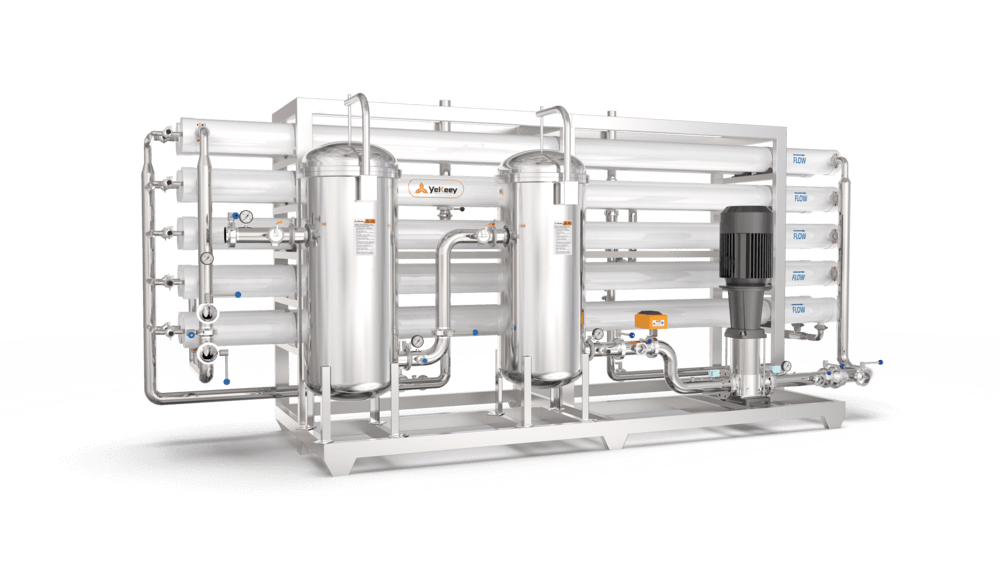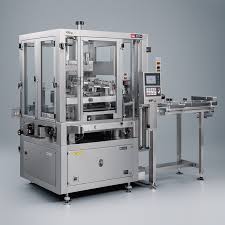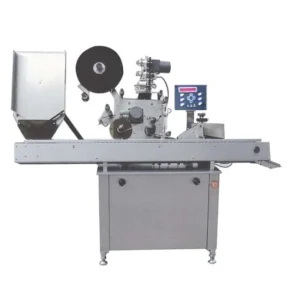Description
| Specification | Details |
|---|---|
| Capacity | 500 gallons per day (GPD) |
| Filtration Process | Reverse Osmosis (RO) |
| Feed Water Source | Municipal water supply or well water |
| Operating Pressure | 40 – 80 psi |
| Recovery Rate | Up to 75% |
| Filtration Efficiency | 95% or greater |
| Membrane Material | Thin Film Composite (TFC) |
| Membrane Type | Spiral wound |
| Pre-filtration | Sediment filter (5 microns) |
| Post-filtration | Carbon filter |
| Operating Temperature | 40°F to 100°F (4°C to 38°C) |
| System Dimensions | 20″ x 10″ x 18″ (L x W x H) |
| Power Consumption | 120V AC, 60Hz, 3A |
| Control Panel | Digital display with push-button controls |
| Material Construction | Stainless steel frame, plastic casing |
| Certification | NSF/ANSI 58 certified for performance |
| Warranty | 1-year limited warranty |
| Additional Features | Automatic shut-off valve, leak detection |
| Low-pressure switch, tank pressure gauge |
Reverse osmosis is a process that makes use of a semi-permeable membrane to remove ions, molecules, and bigger particles from water. The main idea is applying pressure on water to force it through the membrane where impurities remain behind which results in purified water on one side and concentrated contaminants on the other side.
Working Principles of RO Water Treatment Equipment
The working principles of RO water treatment equipment are as follows:
- Pre-filtration: This ensures larger particles, sediments, and debris do not reach the RO membrane. This step helps extend the life of the membrane and enhance system efficiency.
- Pressurization: A pump pressurizes the pre-filtered water against natural osmotic pressure to allow the passage of water molecules through the membrane.
- Membrane Separation: Forced through a pressurized semi-permeable RO membrane, this allows all impurities dissolved salts like heavy metals, bacteria among others from being carried away while only letting H2O pass through.
- Product and Reject Streams: In passing through the membrane, two streams emerge; these are permeate-containing purified water and reject streams carrying concentrated contaminants. Depending on the system design, the most commonly rejected stream is either discharged or recycled.
- Post-treatment: Finally for quality reasons like taste remineralization, pH adjustment, and disinfection may be done during post-treatment of purified water
Applications of RO Water Treatment Equipment
Some areas in which reverse osmosis systems find wide applications include;
a.Residential: These are often found in homes purifying drinking water used for cooking or drinking as well as other domestic purposes.
b.Commercial: Many restaurants, cafes hotels use these units so that they can produce tasty beverages as they maintain their standard culinary offerings
c.Industrial: Pharmaceutical industries electronics manufacturing power plants food processing plants widely depend on reverse osmosis for process water purification, boiler feedwater treatment, and wastewater recycling.
d.Healthcare: Hospitals laboratories and other health institutions will use RO systems to produce ultrapure water needed for medical procedures, laboratory testing, dialysis, etc.
e.Agriculture: In agriculture, they are used for irrigation purposes to provide contaminants and salt-free water to improve the yield and quality of crops.
f.Municipal: Some municipalities utilize RO technology as part of their water treatment infrastructure that converts seawater or brackish into potable water.
Functions of RO Water Treatment Equipment
Several functions are performed by reverse osmosis in water treatment
a.Removal of Contaminants: Dissolved solids salts or heavy metals like pesticides and microorganisms may be eliminated by RO systems from H2O.
b.Desalination: When it comes to desalination of seawater or brackish water, RO technology is very effective thereby making it suitable for areas with limited freshwater supplies or those relying on saline sources.
c.Purification: These RO systems produce purified high-quality drinking waters that meet the required regulatory standards set for this purpose though they are also useful in many other industrial applications as well.
d.Concentrate Management; It ensures that there is a proper management of concentrate disposal/recycling that results in minimized environmental impacts while maximizing utilization of available freshwater resources
e.Scalability: Reverse Osmosis Water Purification Systems can be scaled up or down depending on capacity requirements and hence can be used in both small-scale and large-scale applications.
Advantages of RO Water Treatment Equipment
Adopting RO water treatment equipment comes with many advantages which include;
- Better Water Quality: RO systems produce uncontaminated, odorless, and taste-free water hence ensuring a delightful experience of drinking.
- Health Safety: Through the elimination of harmful pollutants such as bacteria, viruses, and heavy metals, reverse osmosis technology helps maintain public health and prevent waterborne diseases.
- Cost-Effective: As much as the initial price for RO systems is higher compared to conventional filtration methods, long-term cost savings, low maintenance and long lifespan of membranes make it an economical solution in the long term.
- Environmental Sustainability: Through efficient wastewater treatment and recycling, RO technology helps save water resources. It also lowers dependence on single-use plastic bottled water thereby reducing plastic pollution.
- Versatility: The system can be tailor-made according to application requirements and different sources of water therefore offering multiple options for treating water through this method.
Functions of RO Water Treatment Equipment
RO water treatment equipment performs numerous important functions that ensure clean and safe drinking water is available:
- Public Health Protection – By eliminating contaminants and impurities from water, reverse osmosis systems help safeguard public health against diseases caused by contaminated drinking water supplies.
- Water Conservation – Reverse osmosis (RO) technology enables better management and optimum use of scarce natural resources like fresh water by conserving it for future generations through efficiency in usage as well as recycling.
- Industrial Processes – In industries reverse osmosis is critical in producing high-quality process waters while reducing oxidation rates among devices used hence improving quality control measures needed during production phases thus enhancing safety levels associated with products themselves such as drinks that are consumed daily by people around us every day like soda products etcetera without causing harm if taken too often..etc…
d.Environmental Protection – Reduced discharge into aquatic bodies enhances the protection of freshwater ecosystems and maintains the integrity of the environment.
e.Disaster Relief – In periods of calamities and other natural occurrences, patchy areas can be supplied with safe water by deploying RO treatment facilities, hence minimizing impacts associated with water scarcity and contamination issues.
Merits of RO Water Treatment Equipment
RO water treatment equipment is advantageous in that;
- High Efficiency: Reverse osmosis offers higher removal rates for more different types of contaminants leading to highly pure, quality purified water.
- Low Energy Consumption: Modern reverse osmosis systems are designed for low energy use with advanced membrane materials and power recovery devices that minimize power consumption
- Compact Design: Some residential kitchens, commercial establishments (restaurants) or mobile units necessitate small equipment owing to space constraints therefore making it possible to install these systems in such places.
- Easy Maintenance: Everyday operation includes cleaning and replacing the filters that serve as maintenance measures for these machines. Regular maintenance also helps extend living span as well as performance optimization
- Reliability: Continuous operation over long periods demonstrates its reliability while maintaining consistent performance levels and quality standards throughout this time frame.
- Customization: This implies that one can build their system based on their needs since no universally accepted standard will fit everyone’s needs.
Frequently Asked Questions (FAQs)
Q1.What is Reverse Osmosis (RO) technology?
Reverse Osmosis (RO) is a method used to purify water whereby it employs a semi-permeable membrane that removes impurities from it.
Q2.How does RO water treatment equipment work?
The process entails applying hydraulic pressure against raw water forcing it through a semipermeable membrane which in turn rejects salts & dissolved solids found in it among other impurities.…
Q3.What are the primary applications of RO water treatment equipment?
RO systems for drinking water purification, process water treatment, desalination, and wastewater recycling are used in residential, commercial, industrial, healthcare, agricultural, and municipal applications.
Q4. What are the most important advantages of using RO water treatment devices?
In conclusion, this technology offers several benefits such as improved water quality, health protection, cost-effectiveness as well as environmental sustainability, and versatility in water treatment solutions.
Q5. How often should RO membranes be changed?
The length of time between changing membranes is related to various factors including the quality of incoming feedwater, usage patterns, and maintenance practices. Normally it may take anywhere from 2 to 5 years before RO membranes require replacement.
Q6. Is RO water okay to drink?
Yes, it is safe to drink as it undergoes advanced purification processes that obliterate all impurities for high quality and purity.
Q7. Can all contaminants be removed by an RO system?
Although highly efficient in removing several types of pollutants from their source, some substances like dissolved gases or volatile organic compounds cannot be eliminated through the reverse osmosis process requiring additional treatment steps sometimes specific to one contaminant.
Q8. Are these installations ecologically friendly?
Yes, they do due to their role in conserving water resources; reducing pollution impacts plus limiting single-use plastic bottled waters that have become a big issue globally.
Q9. What are some considerations when choosing an RO Water Treatment System?
Some factors include among others: Water Quality/Capacity requirements/System Efficiency/Energy Consumption/Maintenance requirements/Cost Effectiveness.
Q10.Can we use these systems at remote/off-grid locations?
Portable RO units can be solar-powered for use at remote or off-grid locations with limited access to clean drinking water.





Reviews
There are no reviews yet.